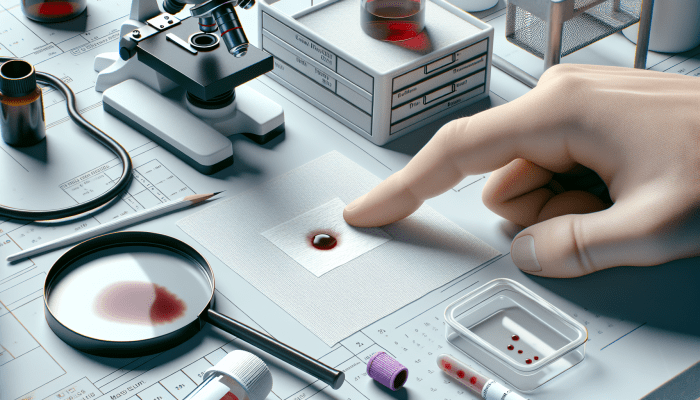Comprehensive Overview of Dried Blood Spot Testing and Its Vital Role in Modern Healthcare
Understanding the Critical Role of Dried Blood Spot Testing in Current Medical Practices

Dried blood spot testing has profoundly transformed blood sample collection and analysis, redefining the diagnostic approaches used by healthcare professionals. This cutting-edge technique entails placing a small drop of blood onto specialized filter paper, which is then allowed to dry before being sent to a laboratory for thorough examination. This innovative method simplifies the sample collection process, significantly reducing the risks associated with traditional techniques like venous blood draws. Its significance is especially evident in areas with constrained healthcare resources, where it enables precise and rapid diagnoses. By adopting this technique, healthcare providers can significantly enhance patient outcomes and implement effective health management strategies that are both accessible and efficient.
The process of collecting samples through dried blood spot testing provides substantial benefits for patients, particularly due to its less invasive nature, making it exceptionally suitable for pediatric care and populations at risk. Dried samples can be preserved for extended periods without refrigeration, which is highly advantageous for public health studies and diagnostics in remote or underserved regions. Additionally, this innovative method facilitates the simultaneous assessment of multiple biomarkers from a single sample, optimizing both time and resources compared to traditional testing methods. The introduction of this testing approach is significantly reshaping the medical diagnostics field, paving new avenues for improved patient care and disease management.
Tracing the Evolution of Dried Blood Spot Testing Through History
The inception of dried blood spot testing can be traced back to the 1960s and 1970s when it was initially utilized for the early identification of metabolic disorders in newborns. Since its inception, there have been notable advancements in both the methodology and the analyses conducted. Rapid technological progress has refined sample collection and analysis techniques, broadening the applicability of this method across various fields within clinical medicine.
In recent years, efforts have intensified to expand the implementation of dried blood spot testing in diverse areas, including the monitoring of infectious diseases, pharmacogenomics, and epidemiological research. This expansion has been significantly driven by substantial improvements in the sensitivity and specificity of testing protocols, alongside the validation of analytical methods that ensure reliable results. Today, this approach is globally recognized as an essential tool for diagnosing and tracking a wide range of health conditions, emphasizing its increasing importance in contemporary medical practice.
Highlighting the Key Advantages of Dried Blood Spot Testing
One of the most notable strengths of dried blood spot testing is its inherently user-friendly design. The straightforward nature of the procedure enables it to be performed in various settings, including hospitals and home environments, thereby significantly improving access to crucial diagnostic testing. Moreover, the sample collection process does not require highly specialized personnel, which effectively lowers operational costs and empowers a broader range of individuals to benefit from this innovative methodology.
Another significant advantage is the portability of dried samples. Once dried, these blood spots can be transported without necessitating special storage conditions, which is particularly beneficial in public health contexts and rural areas. This capability supports large-scale screening initiatives and the monitoring of disease outbreaks. Furthermore, the capacity to analyze multiple analytes from a single sample enhances resource efficiency in medical diagnostics, establishing this technique as a highly effective option for healthcare providers.
Examining Real-World Applications of Dried Blood Spot Testing in Healthcare

Transforming Neonatal Disease Screening with Dried Blood Spot Testing
The use of dried blood spot testing for the identification of neonatal diseases has made a significant impact on the diagnosis and management of potentially life-threatening conditions in infants. This methodology facilitates the early detection of various metabolic, endocrine, and genetic disorders, which is essential for initiating prompt interventions that can save lives. Severe conditions, such as phenylketonuria and congenital hypothyroidism, can be rapidly identified using this method, allowing healthcare practitioners to implement swift treatments that prevent long-term complications and enhance healthier outcomes for newborns.
The establishment of neonatal screening programs utilizing dried blood spot testing has substantially reduced morbidity and infant mortality. Typically, newborns undergo screening within the first 48 hours after birth, ensuring that any identified conditions receive immediate attention and treatment. Additionally, the ability to conduct tests in home or community settings has significantly improved outreach and accessibility, benefiting populations that previously lacked sufficient access to quality healthcare resources.
Advancing Medical Research with Dried Blood Spot Testing
The adaptability of dried blood spot testing extends beyond clinical diagnostics, playing a pivotal role in advancing medical research. Clinical studies frequently utilize this technique to collect blood samples in a minimally invasive manner, enabling longitudinal data collection and ongoing health monitoring over time. Researchers can leverage dried blood samples to analyze biomarkers, conduct pharmacokinetic studies, and evaluate the efficacy of new therapies.
Epidemiological research is also significantly advanced by this innovative method. For instance, studies aimed at assessing the prevalence of infectious diseases such as HIV and hepatitis have effectively utilized dried blood spot testing to examine affected populations in various contexts. The capacity to store and analyze samples over extended periods allows for the accumulation of invaluable data that can inform public health strategies and guide health interventions.
Optimizing Therapy Management with Dried Blood Spot Testing

The application of dried blood spot testing in therapy monitoring is an expanding area of interest, particularly concerning chronic treatments and complex diseases. Healthcare providers can utilize this technique to optimize medication dosages, ensuring that patients receive the precise amount necessary to maximize treatment efficacy while minimizing potential side effects. This precision is especially crucial for medications with a narrow therapeutic index, where accurate dosing is vital for patient safety and treatment success.
Moreover, dried blood spot testing allows healthcare professionals to continuously track drug levels in patients' systems, enabling timely adjustments based on individual responses. This capability is particularly essential in fields such as oncology and pain management, where personalized treatment strategies can significantly enhance patient outcomes. The convenience and effectiveness of this method position it as an invaluable asset in contemporary clinical practice.
Step-by-Step Procedures and Techniques for Effective Dried Blood Spot Testing
Detailed Sample Collection Protocols for Dried Blood Spot Testing
Collecting samples for dried blood spot testing requires meticulous attention to detail to ensure the highest quality results. The process begins with the preparation of essential materials, including specific filter papers and blood collection instruments. Adhering strictly to standardized protocols is crucial to minimize contamination risks and guarantee reliable outcomes.
After preparing all necessary equipment, the subsequent step involves puncturing the patient’s finger or heel, depending on the patient's age and context. The volume of blood required for this test is minimal; typically, only a few drops are necessary. These drops are carefully placed onto the filter paper, ensuring they are adequately absorbed and evenly spread. Following collection, it is critical that the samples dry completely before being stored or sent to the laboratory, as insufficient drying may compromise the samples' integrity.
Advanced Analytical Techniques for Dried Blood Sample Evaluation
The analysis of samples obtained through dried blood spot testing employs a variety of biochemical and molecular techniques. Upon arrival at the laboratory, the dried samples undergo rehydration and preparation for comprehensive analysis. Depending on the specific condition or biomarker being evaluated, methodologies such as mass spectrometry, liquid chromatography, and various immunoassay techniques may be utilized.
Each analytical technique offers unique advantages in terms of sensitivity, specificity, and speed. For example, mass spectrometry is revered for its exceptional accuracy and ability to simultaneously identify multiple analytes. The selection of the most suitable analytical method will depend on the study's objectives and the resources available. Additionally, laboratories must adhere to stringent quality control measures to ensure the reliability of results obtained from dried blood spot testing samples.
Interpreting and Understanding Results from Dried Blood Spot Testing
Interpreting results derived from dried blood spot testing is a crucial process that necessitates specialized expertise and careful consideration. Healthcare professionals must consider numerous factors, including reference values, the patient’s clinical history, and the specific circumstances surrounding the sample collection. Accurate interpretation of test results is vital for informing essential treatment and management decisions for patients.
It is important to acknowledge that while dried blood spot testing serves as a robust diagnostic tool, it cannot replace all conventional diagnostic methods. The results should be contextualized within a broader clinical framework, and in certain cases, additional testing may be necessary to confirm diagnoses or evaluate treatment effectiveness. Clear communication of results between healthcare providers and patients is essential for facilitating informed health management decisions.
Evaluating the Advantages and Challenges of Dried Blood Spot Testing
Significant Benefits of Dried Blood Spot Testing Compared to Traditional Diagnostic Techniques
The advantages of dried blood spot testing over conventional diagnostic methods are numerous and noteworthy. Primarily, the simplicity of the collection process greatly reduces patient discomfort and minimizes the risks associated with invasive procedures. Additionally, the ability to store and transport samples without refrigeration is a decisive factor in its widespread acceptance in both clinical and research environments.
Another major benefit is the capability to analyze multiple biomarkers from a single sample, optimizing resource utilization and time compared to the need for multiple samples for individual tests. This efficiency is particularly crucial in personalized medicine, where comprehensive health profiles can be obtained from a single analysis. Moreover, this technique has proven effective in mass screening efforts, enabling early disease identification in populations that are often difficult to reach, thereby enhancing overall public health outcomes.
Identifying the Challenges and Limitations of Dried Blood Spot Testing
Despite its many advantages, dried blood spot testing also encounters several challenges and limitations that warrant consideration. One primary obstacle is the variability in the quality of collected samples, which can directly impact the accuracy of results. Factors such as the technique utilized for puncturing, drying duration, and the conditions during transportation can all influence sample integrity.
The interpretation of results can be complex, particularly for conditions that require detailed assessments. It is essential for healthcare professionals to receive adequate training to manage and analyze results accurately. Lastly, although the technique has advanced significantly, the validation of new methods and biomarkers remains critical to ensuring the reliability and broad acceptance of dried blood spot testing in clinical practice.
Envisioning the Future of Dried Blood Spot Testing
The future of dried blood spot testing is exceptionally promising, with ongoing advancements in technology and methodologies that continue to expand its applications. The integration of cutting-edge analytical technologies, such as genomic sequencing and metabolomics, allows for a more comprehensive evaluation of patient health and the early detection of emerging diseases.
Additionally, it is anticipated that the incorporation of this technique into public health initiatives will broaden, enhancing access to diagnostic testing in underserved communities. Collaboration among researchers, healthcare practitioners, and regulatory bodies will be vital for overcoming existing challenges and fostering the widespread adoption of dried blood spot testing. As new applications emerge and innovative methods receive validation, this approach holds the potential to revolutionize the diagnosis and management of diseases, establishing itself as a cornerstone of future healthcare.
Case Studies and Real-World Examples of Dried Blood Spot Testing Success
Showcasing Success Stories in Early Disease Detection
Numerous success stories highlight the effectiveness of dried blood spot testing in the early identification of diseases in critical situations. For instance, various countries have implemented this methodology in neonatal screening programs aimed at detecting metabolic disorders. A notable study conducted in Sweden demonstrated that the early detection of phenylketonuria through dried blood spot testing enabled targeted dietary interventions that significantly improved patient health outcomes.
Another significant example is the use of dried blood spot testing for diagnosing infectious diseases. In a public health initiative in Africa, dried blood samples were employed to rapidly diagnose HIV in hard-to-reach communities. This approach not only facilitated timely diagnoses but also enabled immediate interventions to mitigate virus transmission, underscoring the critical role of this testing method in enhancing public health efforts.
Integrating Dried Blood Spot Testing into Public Health Initiatives
The integration of dried blood spot testing into public health programs has emerged as an essential tool in combating both infectious and chronic diseases. This technique has been employed worldwide for epidemiological studies and mass screening initiatives targeting diseases such as malaria and hepatitis. The ability to efficiently collect and analyze blood samples empowers health authorities to make informed decisions and allocate resources effectively to areas in urgent need.
Moreover, dried blood spot testing has markedly improved response capabilities during epidemic outbreaks. During public health emergencies, such as the COVID-19 pandemic, this technique provided a practical tool for surveillance and controlling the spread of the virus, allowing for rapid identification of cases and execution of appropriate public health measures.
Innovative Developments and Future Trends in Dried Blood Spot Testing
Continuous innovations in dried blood spot testing are driving its evolution and expansion within clinical practice. One of the most significant advancements has been the enhancement of analytical technologies, which now enable the detection of biomarkers at lower concentrations and with improved accuracy. This progress has broadened potential applications in areas such as pharmacogenomics, where patient responses to specific medications can be effectively evaluated using a dried blood sample.
Furthermore, the development of portable devices for sample collection and analysis has facilitated the implementation of dried blood spot testing in community and rural environments. These devices empower healthcare professionals to conduct diagnostic testing on-site, significantly improving access to medical care for underserved populations. The future of this technique remains in a state of continuous development, and its integration into clinical practice promises to revolutionize the diagnosis and management of diseases.
Common Questions and Answers About Dried Blood Spot Testing
Is Dried Blood Spot Testing Associated with Pain?
The procedure involved in dried blood spot testing entails a minor puncture in the skin, akin to a needle prick. Most patients report minimal discomfort, as contemporary techniques are designed to alleviate any potential pain.
Where Can I Get a Dried Blood Spot Test?
Dried blood spot testing can be performed in hospitals, clinics, and specialized laboratories. Additionally, various public health programs provide options for home collection.
What Diseases Can Be Detected with Dried Blood Spot Testing?
This testing method is effective in identifying a wide range of diseases, including metabolic disorders, infections like HIV and hepatitis, as well as genetic conditions. Its versatility permits a broad array of diagnostic applications.
What Is the Expected Turnaround Time for Results?
The turnaround time for results from dried blood spot testing can vary by laboratory but typically falls within the range of 3 to 10 days, depending on the specific analysis being conducted.
Is Fasting Necessary Before the Test?
Fasting is generally not required prior to dried blood spot testing. However, it is advisable to adhere to any specific instructions provided by the healthcare professional administering the test.
What Storage Conditions Should Be Followed for Samples?
Samples obtained from dried blood spot testing should be stored in a cool, dry environment, shielded from direct light and humidity. This practice is crucial for maintaining the integrity of the sample until analysis.
Can Dried Blood Spot Testing Serve as a Replacement for Other Diagnostic Procedures?
While dried blood spot testing is a highly effective method, it is not designed to replace all conventional diagnostic techniques. Its application should complement existing procedures based on comprehensive clinical evaluations.
What Are the Expected Costs Related to This Test?
The costs associated with dried blood spot testing may vary depending on the laboratory and specific tests performed. It is recommended to consult with the healthcare institution for precise pricing information.
Are There Any Risks Linked with This Test?
The risks associated with dried blood spot testing are minimal, as the collection involves a minor puncture compared to other methods. However, there is a slight risk of infection at the puncture site.
What Should I Do If My Results Are Abnormal?
If your dried blood spot testing results are abnormal, it is crucial to consult with a physician for appropriate follow-up and to discuss the next steps, including any necessary additional testing.
Connect with us on Facebook!
This Article Was First Found On https://bloodtest.co.uk
The Article: Dried Blood Spot Testing Benefits: A Comprehensive Guide appeared first on: https://ezbloodtest.com
The Article Benefits of Dried Blood Spot Testing: An Essential Overview Was Found On https://limitsofstrategy.com
The Article Dried Blood Spot Testing: Key Benefits Explored First Appeared ON
: https://ad4sc.com





No responses yet